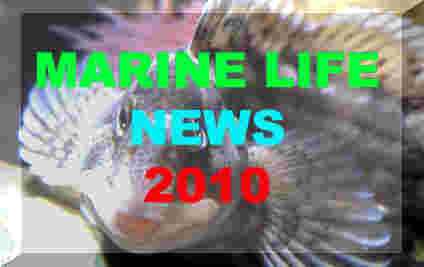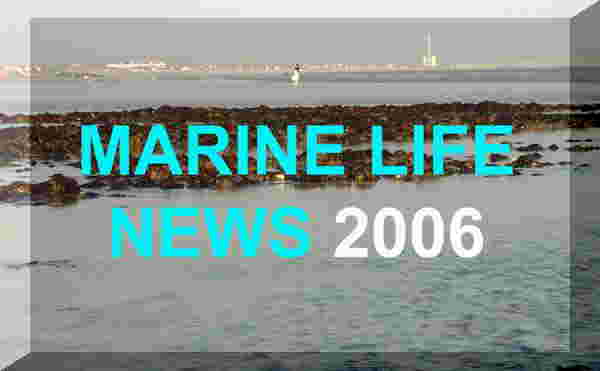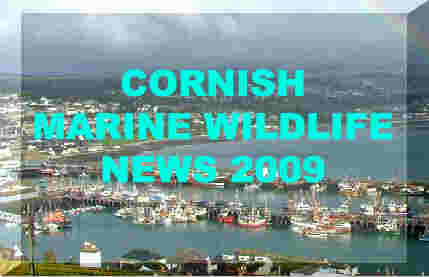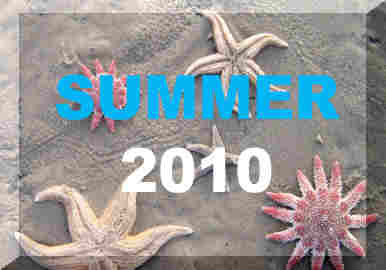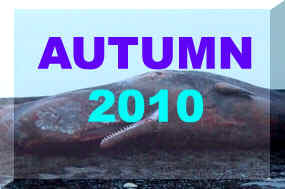LATEST
NEWS:
21
November 2010
An
unprecedented stranding of over a hundred jellyfish
Rhizostoma
octopus were discovered on the beach at Formby,
north Liverpool.
"The jellyfish were literally
uncountable - we walked about a mile along the beach and they stretched
the whole way and out of sight. They were all more than 60 cm in diameter.
The previous high tide was accompanied by a moderate
wind but nothing exceptional, and it was not particularly high."
BMLSS
Jellyfsh
MarLIN
Records of Rhizostoma octopus
15
October 2010
Gary
Crane received a shock when he landed a 4.95
kg (10 lb 14 oz 11 dram) female Marbled
Electric Ray, Torpedo
marmorata,
on
Richard
Seager’s‘Out of Blue‘,
while fishing about three miles to the east of Sark,
Channel Islands. The electric ray had a total length of 58.6 cm and
a disc width of 41.5 cm. The electric
ray took a whole Black
Bream,
Spondyliosoma cantharus,
presented as bait.
BMLSS
Sharks & Rays
BMLSS
Angling Records Links page
BMLSS
Sharks & Ray News
27-28
October 2010
A
pod of at least 24 Long-finned Pilot Whales,
Globicephala
melas, swam into Loch
Carnon,
South Uist,
Outer
Hebrides, Scotland. It is unusual for these cetaceans to swim so close
to the eastern shore of the Western Isles. The increasing narrowness of
the loch meant that there was a possibility of the pod becoming stranded
on the shores of the loch, so the Stornoway
Coastguard called in the British
Divers Marine Life Rescue (BDMLR) and other experts.
When
the whales were in danger of heading towards the head of the loch, local
fish farmers took their boats and having formed a ‘U’ shape behind them,
slowly guided them back out past Cornan
Pier where they were safe from stranding in deeper water 400 metres
offshore.
Map
of the Hebridean Seas
Map
of Carnan Pier Area
BMLSS
Cetaceans
Postscript:
The whales did return to sea but 35+ whales, thought to be the same group,
were discovered
dead on a Rutland
Island beach and nearby in County
Donegal, Ireland, on 7 November 2010.
Images
of the dead Pilot Whales
25
August 2010
A
colourful and scarce discovery of a Streaked
Gurnard,
Trigloporus
lastoviza,
was
captured on video
in Falmouth Bay,
south Cornwall.
Video
on
Kennack
Diving (Facebook)
Kennack
Diving

Streaked
Gurnard
Photograph
by Des Glover
The
Streaked
Gurnard
is
an unusual discovery in British seas, a rare fish north of the English
Channel and usually found at depths in excess of 40 metres in warmer southerly
waters including throughout the Mediterranean Sea.
12
August 2010
A
two metre long Shadefish (a Drumfish),
Argyrosomus
regius, was netted off Portland
Bill, Dorset, and landed at Brixham,
Devon. This
migratory
Mediterranean fish is a rare capture in British seas with only two previous
BMLSS records of complete fish in 1998
and 2008.
The book name Meagre
or Maigre was
a transcription mistake in an old book and I have discontinued its vernacular
use. The capture was of an adult fish weighing
25 kg. This large fish is identified by its
yellow
or salmon-coloured mouth. It preys on other
fishes including Grey Mullet.
BMLSS
Shadefish
13
July 2010
The
MBA
Sepia (coastal research vessel) caught
a small Long-finned Gurnard, Chelidonichthys
obscurus,
in Bigbury Bay,
south Devon. This is only the second one recorded
in British seas.
31
July - 16 August 2010
An
adult Humpback Whale,
Megaptera
novaengliae, was washed ashore off
the coast at St
Ives, Cornwall. The heartbreaking addition to the story was a six metre
long juvenile Humpback Whale had
been seen at nearby Godrevy
attracted to a buoy as though it was his mother. The baby whale slowly
starved to death over a period of two weeks.
30
July 2010
The
now extremely rare Angel Shark (or
Monkfish), Squatina
squatina, was accidentally caught
off
Porthcawl (Wales)
in the Bristol Channel. It weighed 16.7 kg and its length was 123 cm including
the long tail. The shark was collected by the Natural
History Museum for research purposes.
In
2008,
the Angel Shark
received full legal protection from human activities in the waters off
England and Wales from the coast to a distance of 11 km (6.8 mi), under
the UK Wildlife and Countryside
Act. The United Kingdom and Belgium have pushed, unsuccessfully, for
this species to be listed on the Convention for the Protection of the Marine
Environment of the North-East Atlantic (OSPAR) Priority List of Threatened
and Endangered Species.
BMLSS
Sharks
28
June 2010
Dean
Tapley was the first to spot a Sperm
Whale, Physeter macrocephalus,
off
the south coast of Devon in the morning in calm seas. He spent about half
an hour watching the whale and taking pictures before returning to shore
and reporting what he had seen to Paignton Harbourmaster.
"It
was the sound of the water coming out of the blowhole which will stay with
him. It was just so loud," said Dean Tapley.
"It
has been known for these animals to occasionally enter the western English
Channel but very rare for the animal to travel as far east as this and
so close to shore."
BBC
News Report with a Movie Recording
Comments
by Gemma Veneruso (Sea
Watch Foundation)
BMLSS
Cetaceans
Whales
& Dolphins in British Seas
5 June
2010
Adur
World Oceans Day 2010
The
twelfth Adur World Oceans Day went well in the
marquee on
Coronation
Green, by Shoreham
footbridge at the High Street end on the opening Saturday of the Adur
Festival. Len Nevell
of the British Marine Life Study Society was
there with the usual exhibition of lobsters and crabs.

"The
aim of the event is to introduce the young visitors to the world of the
sea
and seashore, an opportunity they may not get. It is an educational
event
with an opportunity for children to participate in the interactive
activities."
Quote
by Andy Horton (British Marine
Life Study Society)
World
Oceans Day on Facebook
4 June
2010
A
Red
Scorpionfish,
Scorpaena
scrofa,
was caught inside Guernsey's 12 mile limit in a scallop dredge. This
warm water and Mediterranean fish is a rare visitor to the English Channel.
This
small fish has venomous
spines on its dorsal, ventral and anal fins. Each spine has a separate
venom gland at the base.
Two
Scorpaena
scrofa have been recorded from Irish waters
so far this year. Scorpaena
scrofa
and
Scorpaena
porcus appear to be more frequently
recorded over the last couple of decades than heretofore. Eleven of these
records date from 1994 and the earliest from 1884.
9
May 2010
A
rarely recorded Oarfish (or Ribbon Fish),
Regalecus
glesne, was found dead in the small
fishing village of Bovallstrand
on the west coast of Sweden, about 90 kilometers (56 miles) from the Norwegian
border. This strange elongated deep sea fish measured 3.5 metres. This
was a relatively small specimen of the longest fish found in the oceans.
The fish was taken to the House of the Sea Museum in Lysekil.
The last recorded discovery of an Oarfish
in
Sweden was in 1879.
Kurt
Ove Eriksson, who discovered the fish, initially
thought the leviathan
was "a big piece of plastic."
BMLSS
Oarfish
Previous
Report on the Northumberland coast 2009
BMLSS
Beachcombing
22
April 2010
A
large Box Crab,
Paramola
cuvieri, was caught 80 miles west
of the Isles of Scilly by skipper Matthew
Keast on his boat Harvest
Reaper while fishing for Turbot.
This
rare species of deep-sea crab, normally found at depths of down to three
kilometres
was landed at Newlyn.
It
was only the seventh recorded since records began in 1900.
Despite its long journey from the depths, the crab, which has a claw span
of more than a metre, appears in reasonable condition and is being looked
after in a specially chilled tank at the Blue
Reef Aquarium in Newquay.
Curator
Matt
Slater said: "It
looks like something from another planet and has caused quite a stir among
all the staff. It's one of the oddest crabs I've ever seen. It has
weird eyes on stalks which look like bicycle handlebars and a strange pair
of backward facing pincers."
Previous
Report in 2004
Paramola
cuvieri on flickr
BMLSS
Crustacea
19
April 2010
Recreational
angler Troy Waterman
discovered the third (and his second) British record of the alien Asian
Shore Crab, Hemigrapsus
sanguineus, on the southern end of
the west coast of Guernsey in the Channel Islands. It was a female and
alive. with a carapace width measured at 23 mm.
The
Asian
Shore Crab has a square-shaped shell with
three spines on each side of the carapace.
Hemigrapsus
sanguineus is indigenous to the western
Pacific Ocean from Russia, along the Korean and Chinese coasts to Hong
Kong, and the Japanese archipelago. This species is an opportunistic
omnivore, feeding on macroalgae, salt marsh grass, larval and juvenile
fish, and small invertebrates such as amphipods, molluscs,
Barnacles,
and polychaete worms. It is highly reproductive
with a breeding season from May to September. This versatile crab inhabits
any shallow hard-bottom intertidal or sometimes subtidal habitats. This
species has the potential to become an established competitor with native
crabs.
Previous
Record
Further
Information (by Richard Lord)
17-22
February 2010
A
17 metre long Fin
Whale, Balaenoptera
physalis, was spotted by Jean
Lawson floating about three kilometres off
the shore of north Cornwall. The dead mammal then floated north-east until
five days later the huge whale washed up in a cove near Porthtowan,
37 miles away from the first sighting.
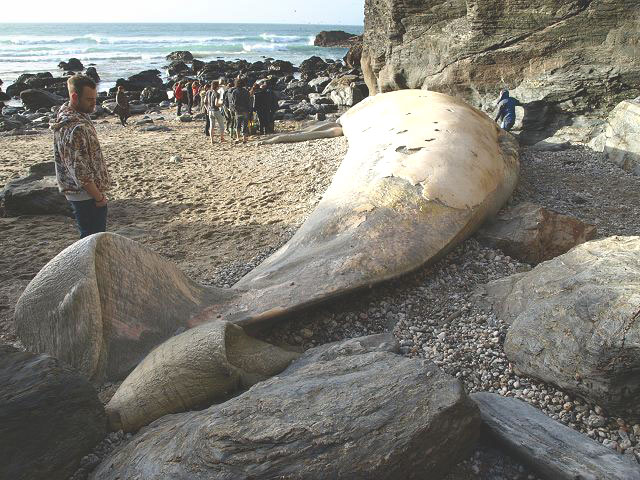
Fin Whale washed
up at Porthtowan
Photograph
by David Fenwick Snr
More
Images
Previous
Report
Cornish
Wildlife Trust Marine Strandings Network
BMLSS
Cetaceans
1 February
2010
On
going back up Marazion Beach, south Cornwall,
as the tide turned (on the lowest tide of the year)
my partner and I looked around some uppershore pools
and discovered five Giant Gobies, Gobius
cobitus. in three small pools. They averaged
about 18 cm in length.
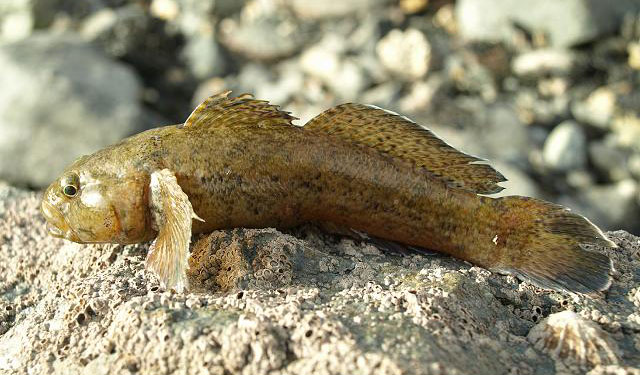
Giant Goby
Photograph
by David Fenwick Snr
This
large goby is a very rare find on the south-west shores of Britain and
the Channel Islands. The Giant
Goby is a protected species under the Wildlife
and Countryside Act Schedule 5.
Full
Report & Photographs (Link)
Aphotofauna
BMLSS
Giant Goby Reports
BMLSS
Gobies
25
January 2010

A ten
metre long Sperm Whale, Physeter
macrocephalus,
was discovered after becoming stranded on rocks at Beadnell
Bay on on the Northumberland
Coast, north-east England. The whale had been dead for several days.
Whales
& Dolphins in British Seas
The
last BMLSS recorded stranding of a deep water
Sperm
Whale on the English North Sea coast occurred
when two were stranded in separate incidents
on North Sea coasts in February 2006.
BMLSS
Cetacean Reports
3 January
2010
Nineteen
Ray's
Bream,
Brama
brama, were discovered on the beach at Redcar,
north Yorkshire on the east coast of England.
November
2009 - January 2010

Ray's
Bream
Photograph
by Bill Ashton-Wickett
Frequent
reports of Ray's Bream,
Brama
brama, being washed ashore on North Sea were received. These strandings
occurred in 2009
and earlier years.
List
of 2009-2010 Reports
More
Reports of Ray's Bream on flickr
British
Marine Life News 2009

Cornish
Marine Life Records 2009
BMLSS
Oil Disasters page



